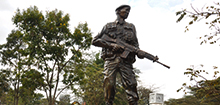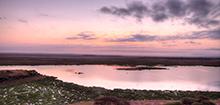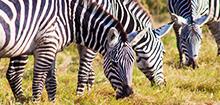Date Published:
Kenya Wildlife Service in collaboration with World Wide Fund for Nature (WWF) on June 26, 2018 commenced translocation of eight black rhinos from the Nairobi National Park to Tsavo East National Park (TENP).
Tourism and wildlife Cabinet Secretary, Najib Balala officially launched the translocation at the ivory burning site inside Nairobi National Park where he also received equipment donated by WWF to support KWS rhino monitoring team .The equipment consist of 2 vehicles, 3 motorbikes, cameras, computers, binoculars, and tents among others.
Tuesday June 26, 2018 three rhinos were captured by a highly specialized KWS capture team using a helicopter to round them up after which they were immobilized by veterinary doctors and scientists, then loaded into containers before being ferried by trucks to Tsavo East National Park.
A similar exercise will be carried out on Friday June 29, 2018 to capture and translocate three more rhinos to TENP with the remaining two of the targeted eight being moved on Monday July 2, 2018. A similar translocation exercise will be undertaken in Nakuru National Park where six more black rhinos will be moved to TENP on July 5th and 8th, 2018.
A total of 14 rhinos will therefore be translocated from the Nairobi National Park and Nakuru National to Tsavo East National Park in a new rhino sanctuary. The sanctuary in the expansive park is a joint effort between WWF and KWS, with WWF being the main funders.
By the end of 2017, Kenya had a rhino population of 1,258 (745 Black rhinos, 510 southern white rhinos and 3 Northern white rhinos, the only surviving northern White rhino Male died in March 2018, thus only 2 females remain) having grown from less than 400 rhinos in 1980's.
This indicates that the population has gradually been growing despite challenges. This has been the result of concerted efforts from KWS, private landholders, communities, county Governments, local and international partners. However these efforts must be sustained as the numbers remain relatively low and the species remains critically endangered.
Despite the successes, threats continue to persist including poaching due to the increased demand for rhino horn, inadequate financial resource, and limited secure space for expanding the rhino range. With the increasing challenges, investing in rhino conservation has become an expensive venture which requires the collaboration of all the relevant conservation partners and government agencies.
To achieve desired meta-population growth rates and strengthen national rhino population gene pool, rhino translocations and stocking density management are key biological management components. This is realized by translocation of unrelated individuals from different populations based on set percentage harvesting to maintain high growth for maintaining genetic diversity and rhino health in both the source and recipient population.
The launch was also witnessed by WWF Chief Executive Officer Mohamed Awer, KWS Chairman, Board of Trustees, Dr. John Waithaka and KWS acting Director General Mr. Julius Kimani. Dr. Waithaka said KWS plans to launch the 6th edition of the Black Rhino Conservation Strategy and Action Plan (2017-2021) in July 2018. The overall goal of the Strategy and Action Plan is to achieve a meta-population (national herd) of 830 black rhinos by the end of 2021.
The strategic plan outlines the use of well-established sanctuary populations as a ‘breeding bank’ of actively managed rhinos for the provision of a continuous supply of surplus rhino to create additional secure sanctuaries and to restock former rhino range.





